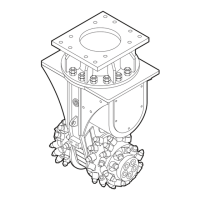Depressurising the hydraulic
system
Even when you have switched off the carrier, a
considerable residual pressure can still be present
in the hydraulic system.
A residual pressure can still be present in the
hydraulic attachment even after you have
disconnected the quick-release couplings or closed
the shut-off valves.
The hydraulic attachment can only be
depressurized using the hydraulic system of the
carrier, by allowing hydraulic oil to drain to the tank
via the return connection.
Depending on the type of hydraulic attachment, the
internal leaks, the oil temperature, the type of
hydraulic oil and the design of the hydraulic
installation of the carrier, the time required to
relieve the pressure can vary.
Observe the following steps in order to
depressurise the hydraulic attachment:
1. Ensure that the hydraulic oil in the hydraulic
attachment and in the carrier has a
temperature of at least 0 °C. If necessary, pre-
heat it to at least 0 °C.
2. The hydraulic attachment must be connected to
the hydraulic system of the carrier device, i.e.
the hydraulic hoses must be connected up and
the respective shut-off valves in the supply pipe
and in the connection to the tank must be
opened.
3. Place the hydraulic attachment on timber
support blocks laying on the ground.
4. Depressurise the hydraulic system according to
the manufacturer's safety and operating
instructions for the carrier.
5. You must wait at least another 60 minutes until
the pressure has been relieved through
leakages.
6. When you have made sure that no more
pressure is present in the hydraulic system,
you must disconnect the hydraulic connection
to the carrier. Close the shut-off valves or
disconnect the quick-release couplings, so that
no hydraulic oil can flow back from the carrier.
Cleaning
Clean the transverse drum cutter daily after use.
NOTICE Environmental damage due to hydraulic
oil
Hydraulic oil is environmentally harmful and must
not penetrate the ground or enter the water table
or water supplies.
►
Collect any hydraulic oil which escapes.
►
Dispose of it in accordance with the applicable
environmental regulations.
NOTICE Damage due to improper cleaning
►
Never strike the round attack picks, cutter
drums or the gear with a hard object, e.g. a
hammer, in order to free them of a trapped
fragment or contaminant.
Note: When cleaning with a high pressure cleaner,
be aware of the safety labels. These must not be
damaged by a water jet.
◆
Wipe clean areas to which safety labels are
attached by using a cloth.
◆
Clean all other areas of the transverse drum
cutter thoroughly with water.
◆
Remove contaminations in the intermediate
spaces between the round attack picks and pick
boxes.
◆
Ensure that no residual contaminants are
located beneath the pick (e.g. fresh concrete).
Such residue could harden and set the picks
fast in the boxes.
Checking bolted connections
◆
Secure the carrier such that it cannot move
unexpectedly.
DC 200, 400, 600, 1000, 1200, 2000, 2100, 2900 Safety and operating instructions
© Construction Tools GmbH | 3390 5192 01 | 2016-12-01
Original instructions
41

